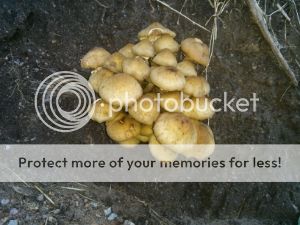So, if anyone is interested and wants to have a go, I’ve done pretty tentative IDs on a couple of fungi today.
I’m wondering if this could be a Gymnopilus. No, I didn’t find an opened one, and I didn’t cut this one. So it’s a bit hard to ID.
So, if anyone is interested and wants to have a go, I’ve done pretty tentative IDs on a couple of fungi today.
I’m wondering if this could be a Gymnopilus. No, I didn’t find an opened one, and I didn’t cut this one. So it’s a bit hard to ID.
Morrie’s your man.
The first one might be a Gymnopilus as they do have a cap texture like that at times, but it is hard to tell since you can’t see if it has gills or pores. It also looks very much like an emerging fruiting body of Boletellus ananiceps that I get around here, but these are a hot weather fungus, emerging in mid summer.
The others don’t look like Suillus luteus to me. The cap doesn’t look right, neither does the intersection of the pores and the stem, nor the stem itself and there doesn’t appear to be an annulus, though the tape may be hiding it. Boletes are many and varied and not well described in Australia. Even within Suillus there are quite a few species apart from the common S. luteus and S. granulatus.
While you’re at it…


poikilotherm said:
While you’re at it…
Second one looks like a cluster of Armillaria. Possibly Armillaria luteobubalina.
buffy said:
Thanks morrie. I’ve got them as queries in my photos. This one is pretty surely an Amanita…
morrie said:
poikilotherm said:
While you’re at it…!http://i885.photobucket.com/albums/ac54/pseudotrop/7bcae5fd-37a5-419c-a6d2-9d07bb3404c9_zpsf3a585ec.jpg
!http://i885.photobucket.com/albums/ac54/pseudotrop/c3066122-972e-47aa-9853-8ca601b83370_zpsea07182d.jpg
First one: too hard. As I mentioned, boletes are not well described.Second one looks like a cluster of Armillaria. Possibly Armillaria luteobubalina.
Thanks.
What do you think of this site morrie?
http://www.mycokey.com/newMycoKeySite/MycoKeyIdentQuick.html
poikilotherm said:
morrie said:
poikilotherm said:
While you’re at it…!http://i885.photobucket.com/albums/ac54/pseudotrop/7bcae5fd-37a5-419c-a6d2-9d07bb3404c9_zpsf3a585ec.jpg
!http://i885.photobucket.com/albums/ac54/pseudotrop/c3066122-972e-47aa-9853-8ca601b83370_zpsea07182d.jpg
First one: too hard. As I mentioned, boletes are not well described.Second one looks like a cluster of Armillaria. Possibly Armillaria luteobubalina.
Thanks.
What do you think of this site morrie?
http://www.mycokey.com/newMycoKeySite/MycoKeyIdentQuick.html
There is the Fungimap website, newly revamped:
http://www.fungimap.org.au/index.php/learn-about-fungi
buffy said:
There is the Fungimap website, newly revamped:
http://www.fungimap.org.au/index.php/learn-about-fungi
I tried that one, didn’t help. Pity the other one isn’t Aus relevant.
poik, get hold of a copy of Bruce Fuhrer’s field guide to Australian fungi. I just start in the relevent section and flip through the picture until I find something similar. You can then work from there.
It seems to be the Bible of fungi.
And elfram from the old Scribbly Gum has a great website too:
http://www.elfram.com/fungi/fungi_home.html
buffy said:
poik, get hold of a copy of Bruce Fuhrer’s field guide to Australian fungi. I just start in the relevent section and flip through the picture until I find something similar. You can then work from there.
It seems to be the Bible of fungi.
But not necessarily of WA fungi.
PermeateFree said:
buffy said:poik, get hold of a copy of Bruce Fuhrer’s field guide to Australian fungi. I just start in the relevent section and flip through the picture until I find something similar. You can then work from there.
It seems to be the Bible of fungi.
But not necessarily of WA fungi.
morrie said:
PermeateFree said:
buffy said:poik, get hold of a copy of Bruce Fuhrer’s field guide to Australian fungi. I just start in the relevent section and flip through the picture until I find something similar. You can then work from there.
It seems to be the Bible of fungi.
But not necessarily of WA fungi.
Pretty good for WA. But Bougher and Syme is probably more useful for the common species.
There are others.
PermeateFree said:
morrie said:
PermeateFree said:But not necessarily of WA fungi.
Pretty good for WA. But Bougher and Syme is probably more useful for the common species.There are others.
morrie said:
PermeateFree said:
morrie said:Pretty good for WA. But Bougher and Syme is probably more useful for the common species.
There are others.
I am aware of that. But Bougher and Syme remains the most useful IMHO.
shrugs
PermeateFree said:
morrie said:
PermeateFree said:There are others.
I am aware of that. But Bougher and Syme remains the most useful IMHO.shrugs
morrie said:
PermeateFree said:
morrie said:I am aware of that. But Bougher and Syme remains the most useful IMHO.
shrugs
Do you have a copy? It has a picture of Cortinarius archeri on the cover.
I think we have different reference material. I took hundreds of fungi photos over several years with the aim of producing a fungi id blog for my area, but with so many species unknowns, plus lack of time, I lost interest and stuck with my botany projects.